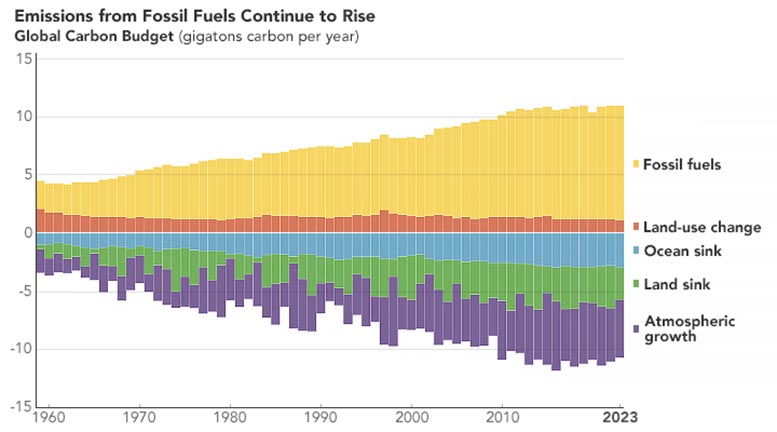Carbon dioxide emissions are increasing rapidly
- March 8, 2024
- 0
Scientists’ annual review of the world’s carbon cycle has found that burning oil, coal and natural gas is hindering progress on limiting climate change. According to the predictions
Scientists’ annual review of the world’s carbon cycle has found that burning oil, coal and natural gas is hindering progress on limiting climate change. According to the predictions

Scientists’ annual review of the world’s carbon cycle has found that burning oil, coal and natural gas is hindering progress on limiting climate change. According to the predictions of an international group of scientists, carbon dioxide emissions from fossil fuels will increase again and reach record levels in 2023. Scientists say the steady increase in emissions from burning oil, coal and natural gas is hindering progress in limiting global warming.
The discovery is part of an annual review of Earth’s carbon cycle called the Global Carbon Budget. In this annual assessment, scientists measure how much carbon is added to the atmosphere due to burning fossil fuels and changes in land use, as well as how much carbon is removed from the atmosphere and stored on land and in the ocean.
Scientists’ initial analysis of 2023 data shows that fossil fuel emissions increased by 1.1 percent in 2023 compared to 2022 levels, with total fossil fuel emissions reaching 36.8 billion metric tons of carbon dioxide in 2023. When other sources such as deforestation and Canada’s extreme wildfire season are taken into account, total emissions in 2023 are estimated to be 40.9 billion metric tons. According to the analysis, record increases in carbon emissions from fossil fuels were seen in both 2023 and 2022.
“Emissions are moving in the wrong direction, where we need to limit global warming,” said Ben Poulter, a scientist at NASA’s Goddard Space Flight Center who co-authored the report. The concentration of carbon dioxide in the atmosphere increased from 278 parts per million in 1750 at the beginning of the industrial age to 420 parts per million in 2023.
The increase in heat-trapping carbon dioxide and other greenhouse gases is the main reason why the planet’s temperature is rapidly increasing. Global surface temperatures in 2023 were 1.2 degrees Celsius (2.1 Fahrenheit) above NASA’s baseline period (1951-1980) average, making the year the warmest on record.
The visualizations above show the flow of carbon dioxide into, around, and out of Earth’s atmosphere throughout 2021 (the last year for which data is available). They rely on NASA’s Goddard Earth Observing System (GEOS), a modeling and data assimilation system used to study Earth’s weather and climate. Researchers used data on vegetation, population density and the locations of wildfires, power plants, roads, railways and other infrastructure to show where carbon is emitted or absorbed.
The carbon dioxide shown in the visualizations comes from four main sources: fossil fuels (yellow), burning biomass (red), terrestrial ecosystems (green), and the ocean (blue). Although land and oceans are carbon sinks, meaning they store more carbon than they emit by removing carbon dioxide from the atmosphere, they can also be sources at certain times and places. Green and blue dots represent carbon absorbed by land and ocean.
“Surprisingly, the ocean and land continue to absorb about half of the carbon we emit,” Poulter said. “Only 44 percent of emissions remain in the atmosphere each year, slowing the pace of climate change but causing ocean acidification and altering the functioning of terrestrial ecosystems.”
The proportion of carbon dioxide that remains in the atmosphere (known as the atmospheric fraction) has remained fairly constant over the past 60 years, even as human-caused emissions have increased steadily. However, scientists are doubtful whether this stability will continue and how long it will last.
A NOAA-led study published in 2023 analyzed ocean carbon accumulation over two decades and found evidence that this carbon pool may be losing some of its capacity. They suggest that the ocean slows its absorption because it has already accumulated significant amounts of carbon dioxide. And changes in global ocean circulation could reduce the amount of carbon transported from surface waters to the ocean floor, where it can be stored for hundreds of years.

The Global Carbon Budget used a variety of data sources to get a complete picture of the Earth’s carbon cycle. The main sources were emissions inventories compiled by governments and energy utilities. Satellite data from NASA’s OCO-2 (Orbiting Carbon Observatory-2) instrument was also used to estimate the flux of carbon between land and the atmosphere.
Carbon dioxide emissions are falling slightly in some regions, including Europe and the United States, but are still rising globally, according to the report. India and China were the countries where emissions increased the most in 2023.
In December 2015, delegates from 196 countries agreed on the Paris Agreement, which called for global average temperatures to be “maintained at 2 degrees Celsius above pre-industrial levels” and to “efforts to limit the increase to 1.5°C.” The Global Carbon Budget team also analyzed the remaining carbon budget before emissions push the planet by 1.5 degrees. They estimate that at current emissions levels, “there is a 50 percent chance that global warming will be sustained above 1.5°C in about seven years.”
NASA and other U.S. federal agencies regularly collect data on greenhouse gas concentrations and emissions, pictured above. These data are now available in the newly launched U.S. Greenhouse Gas Center, an interagency project that combines information from observations and models to provide decision makers with a single location for data and analysis.
Source: Port Altele
As an experienced journalist and author, Mary has been reporting on the latest news and trends for over 5 years. With a passion for uncovering the stories behind the headlines, Mary has earned a reputation as a trusted voice in the world of journalism. Her writing style is insightful, engaging and thought-provoking, as she takes a deep dive into the most pressing issues of our time.